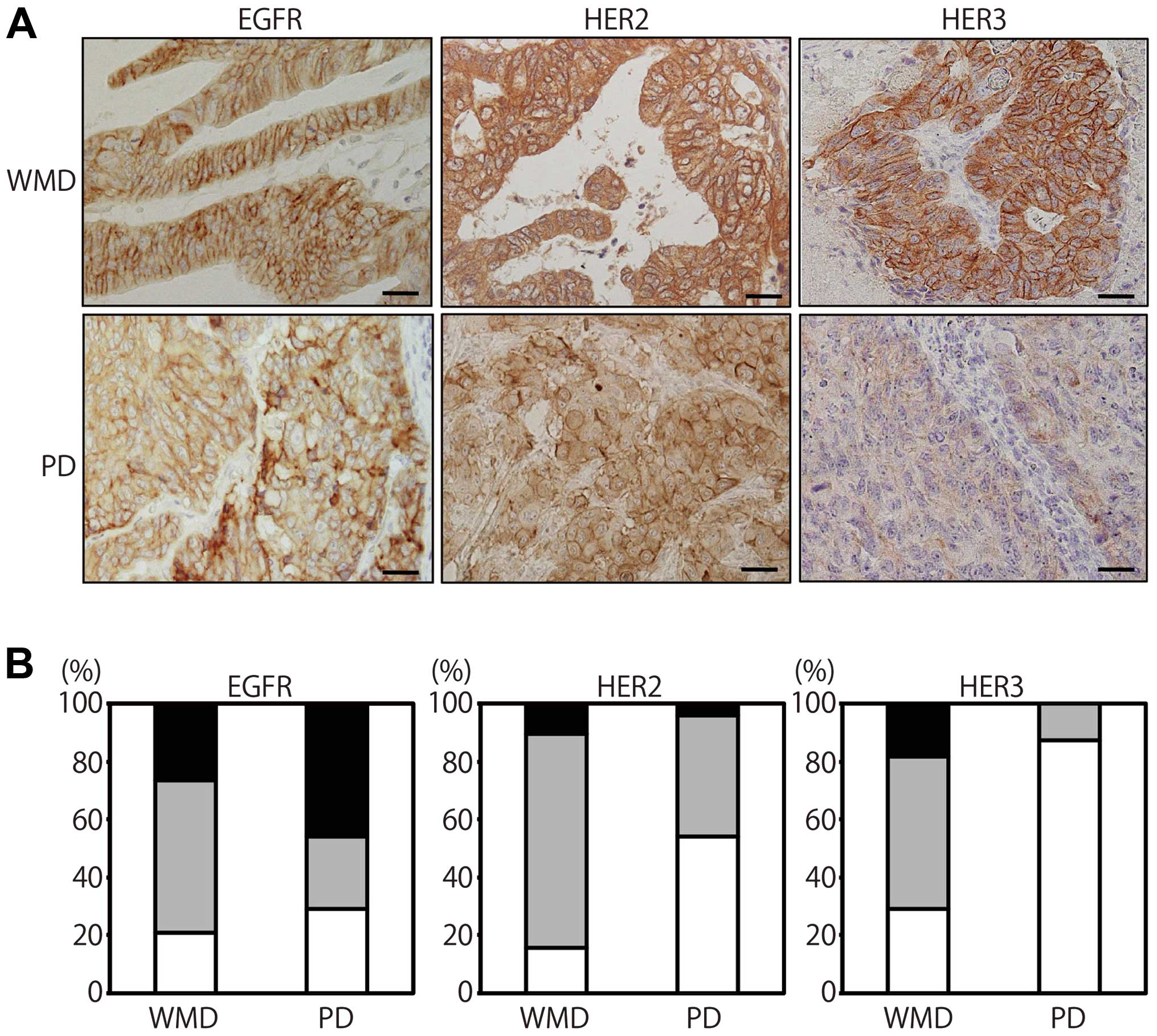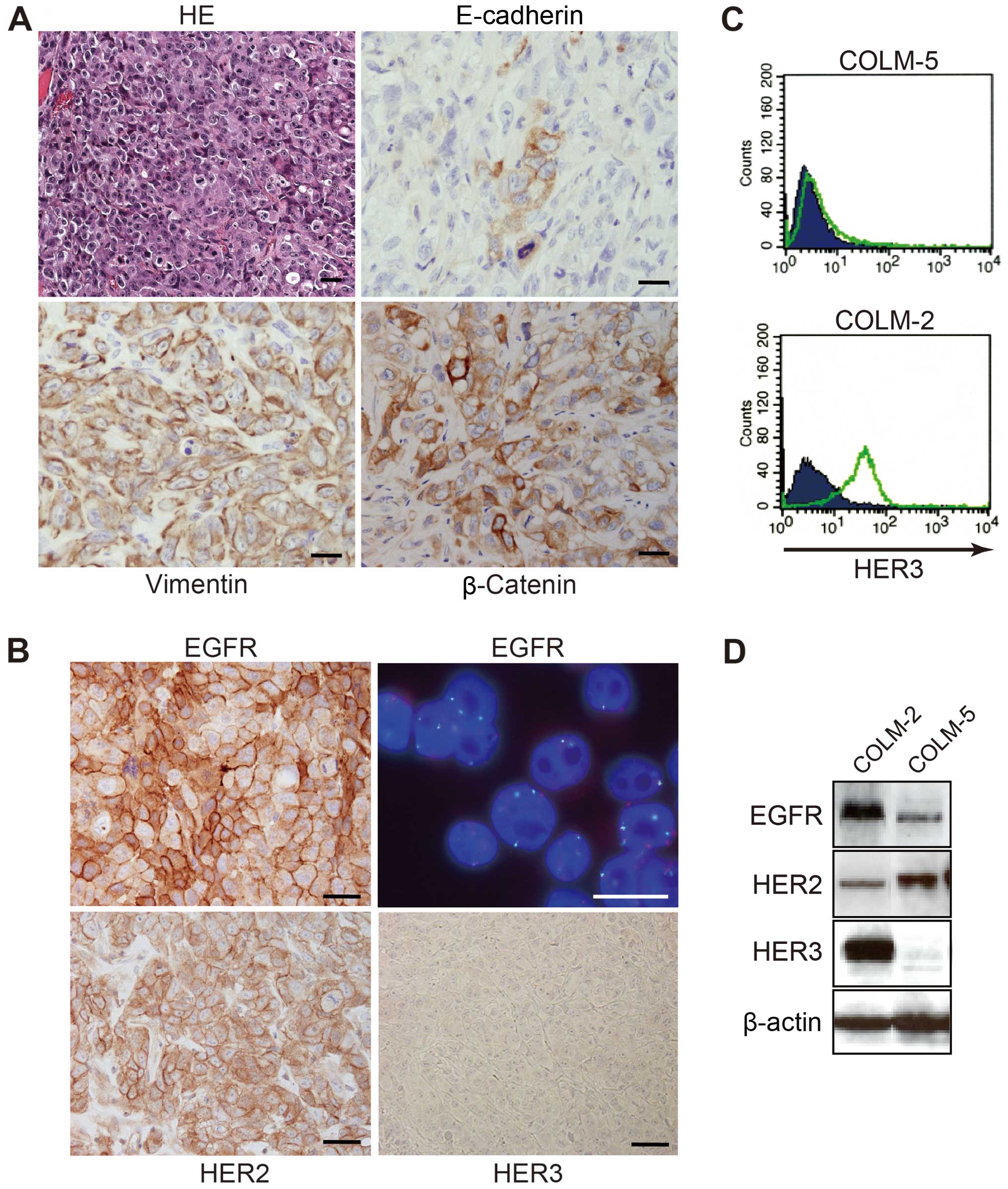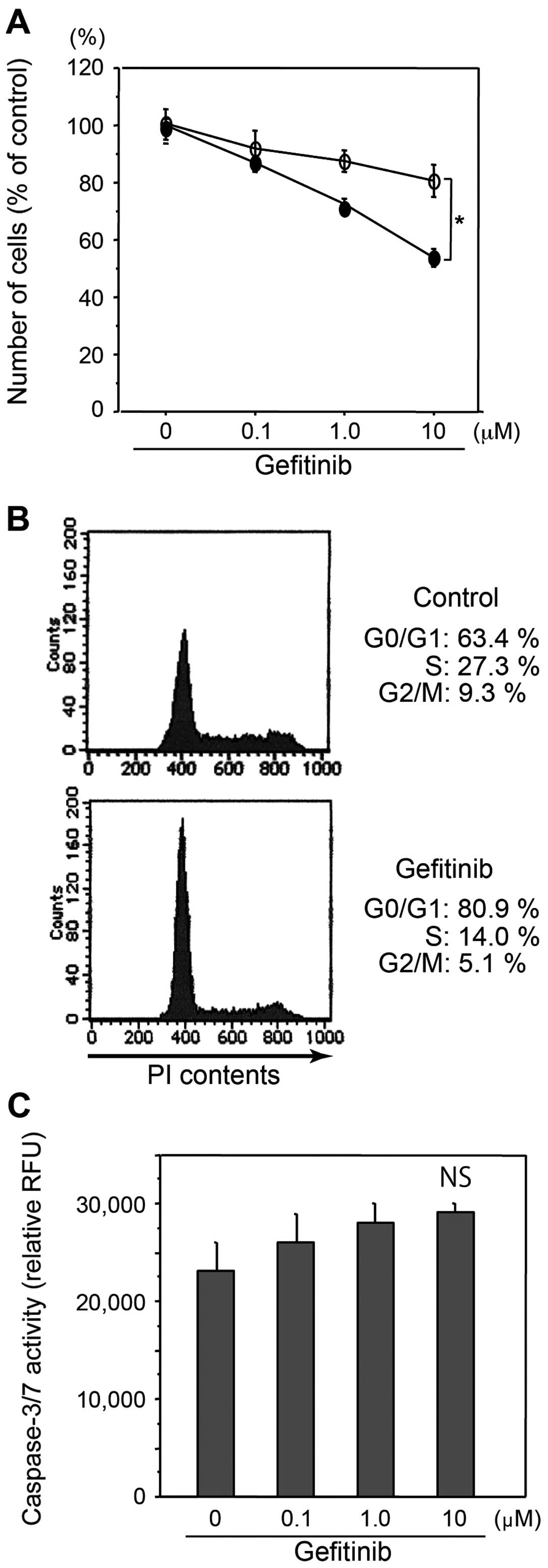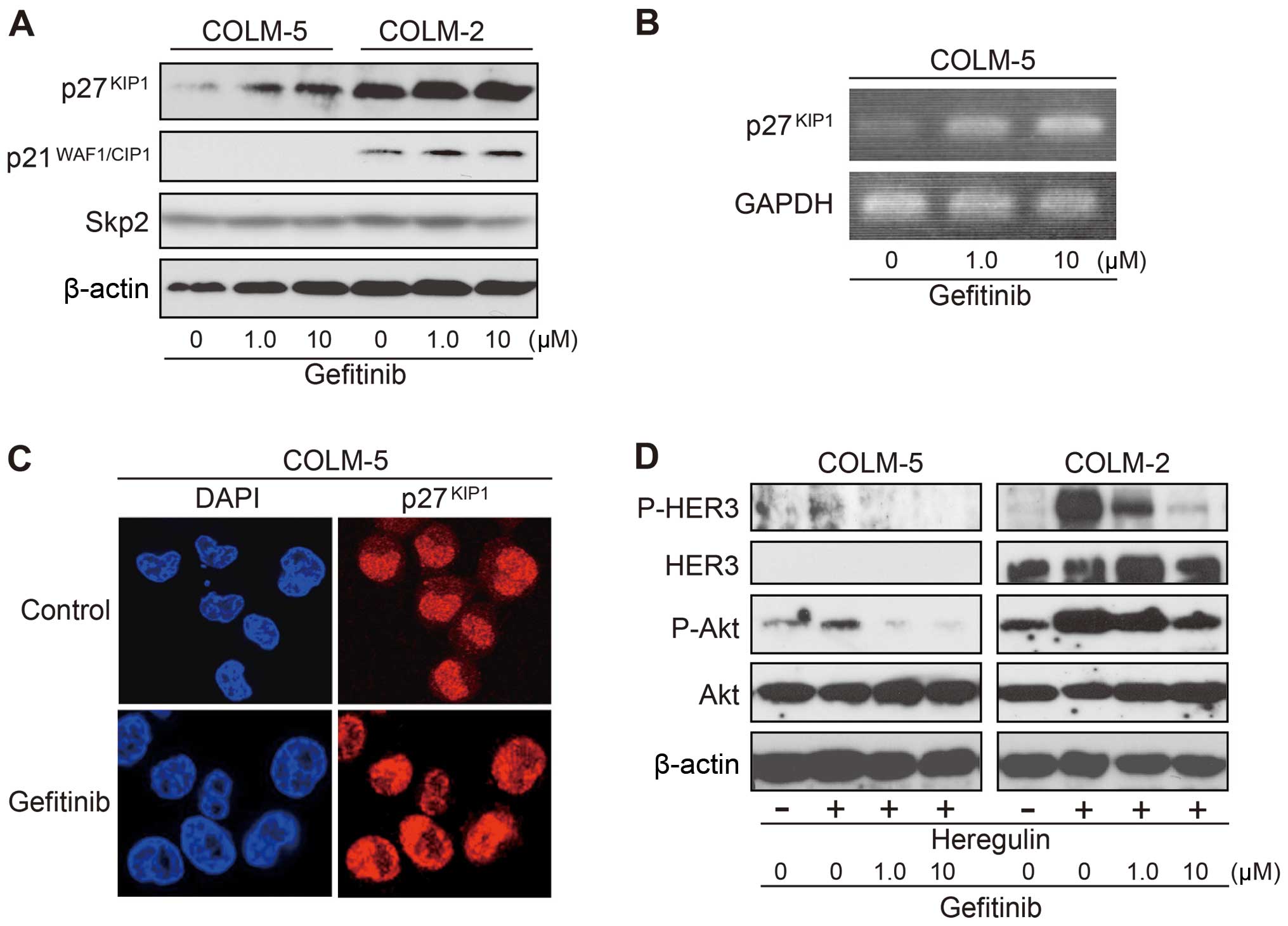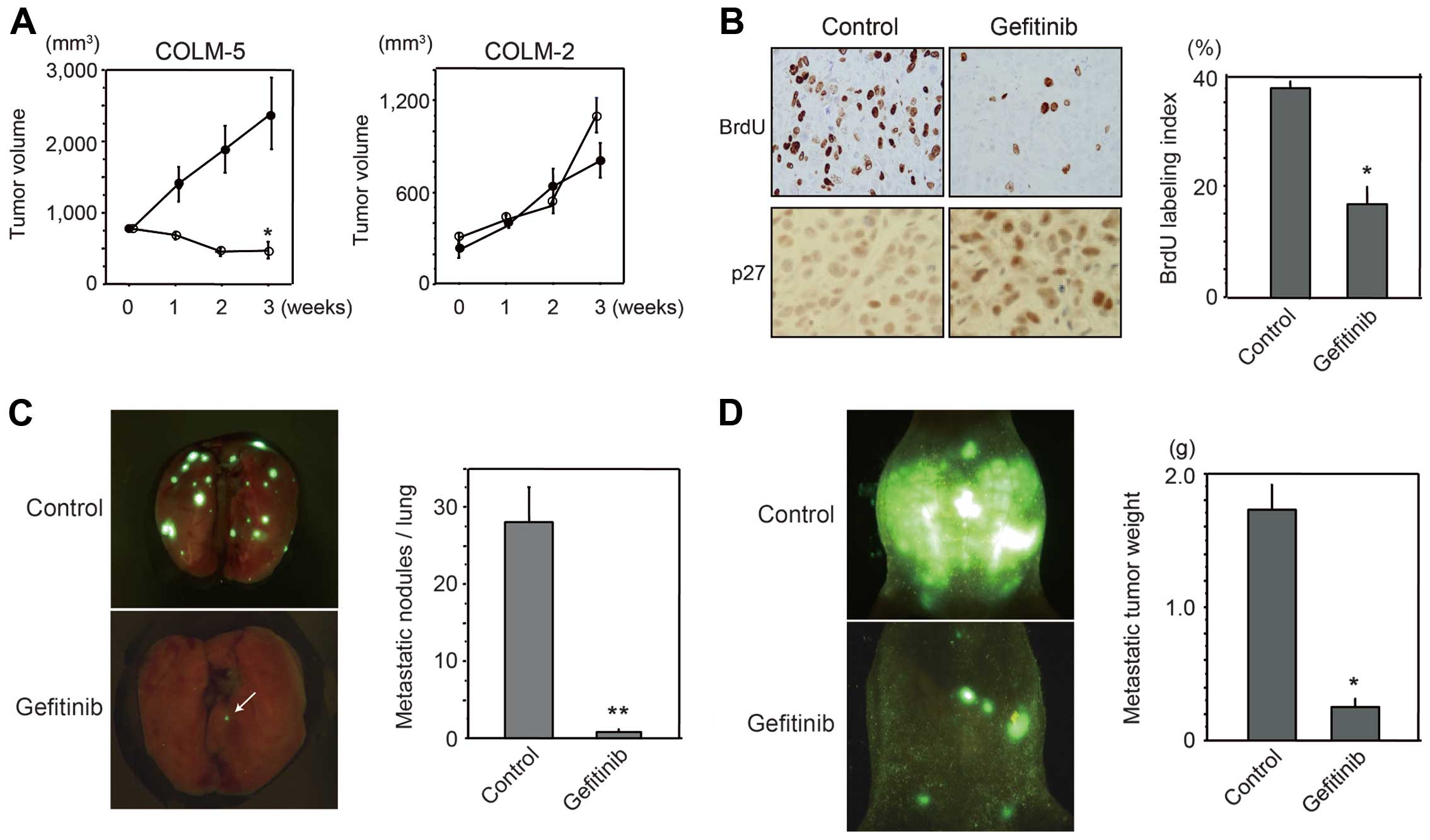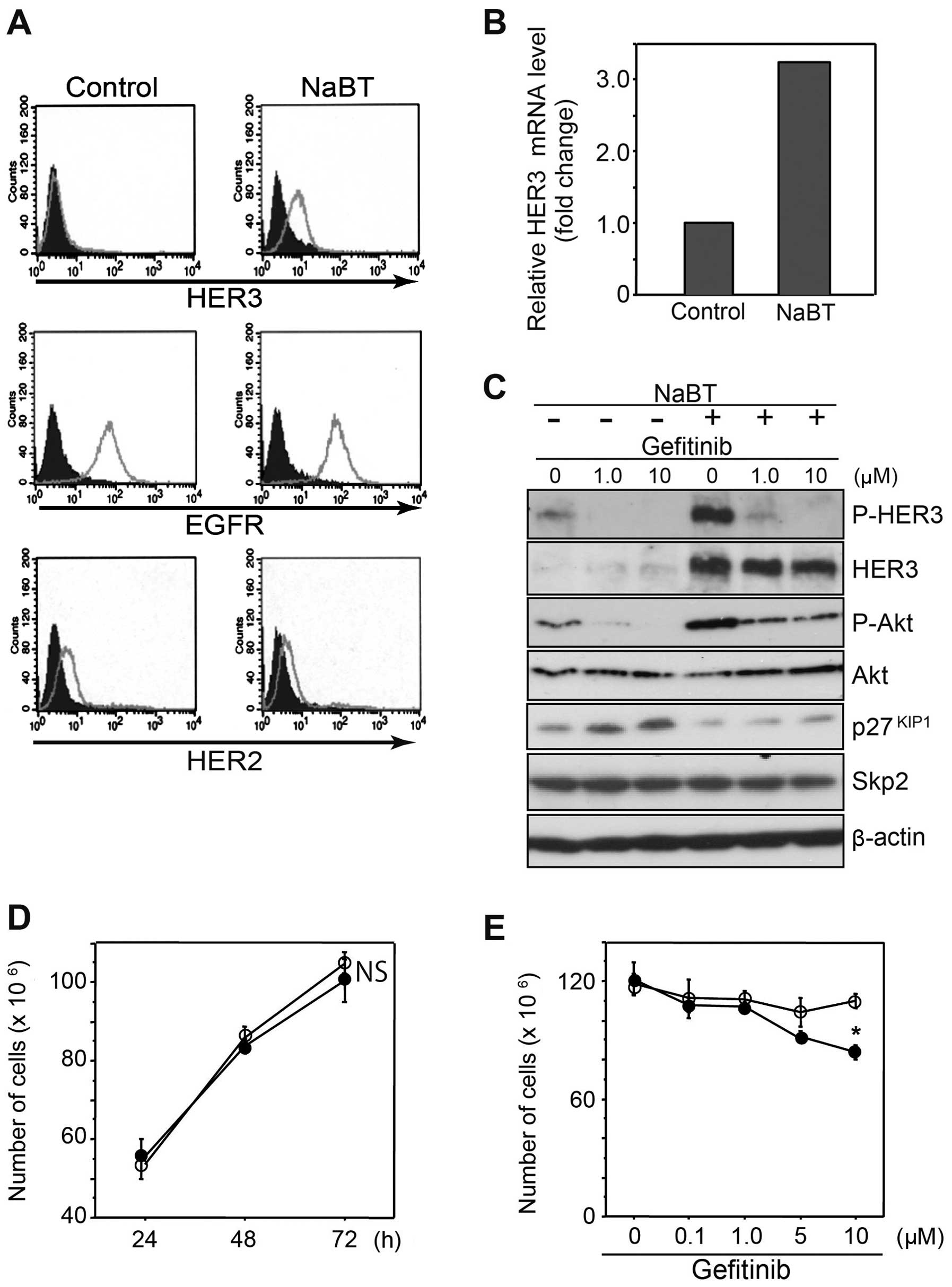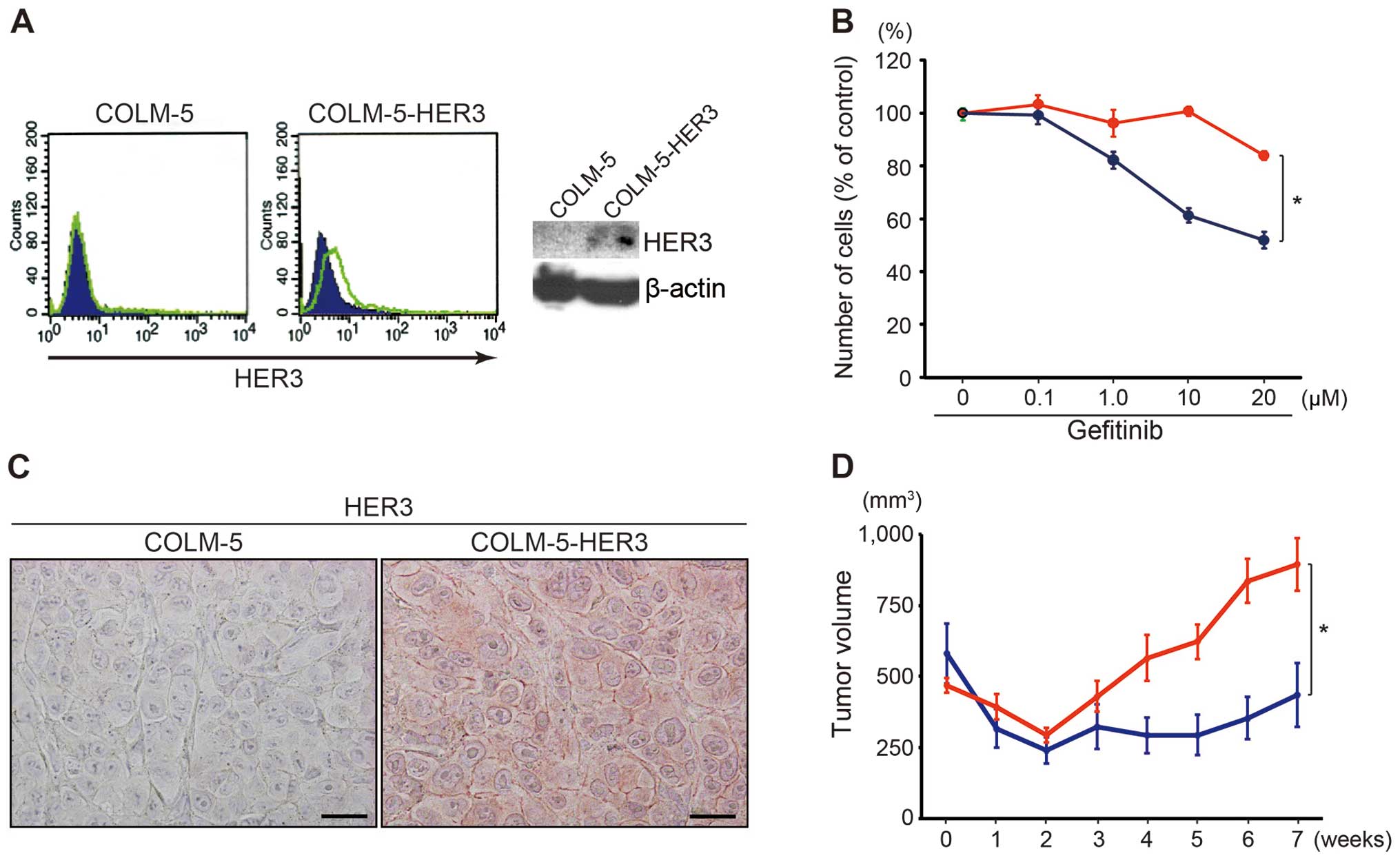Deficient HER3 expression in poorly-differentiated colorectal cancer cells enhances gefitinib sensitivity
- Authors:
- Published online on: July 8, 2014 https://doi.org/10.3892/ijo.2014.2538
- Pages: 1583-1593
Abstract
Introduction
The majority of CRC are well- to moderately-differentiated adenocarcinomas (WMD-CRC) with apparent glandular morphology. Pathogenesis of such a differentiated-type CRC is a multistep process, recognized as an adenoma-carcinoma sequence, starting from a polypoid lesion such as adenoma, with subsequent progression to adenocarcinoma, and finally metastatic adenocarcinoma (1). Throughout this process, a series of genetic alterations such as mutation in APC, β-catenin, KRAS, p53 and TGF-βR-II and microsatellite instability (MSI) are known to be accumulated with disease progression (2). Among these changes, mutations in Wnt signaling cascade such as APC and β-catenin occur at the initial step and play a key role in carcinogenesis of WMD-CRC (3). In contrast, poorly-differentiated adenocarcinomas (PD-CRC), defined by minimal glandular structure (1), are relatively rare accounting for only 5–10% of CRCs (4), and molecular pathogenesis and clinicopathological features are reportedly distinct from WMD-CRC (5). PD-CRC is heterogeneous and has been subclassified into several types (6). One relatively rare subset of PD-CRC is ‘medullary type adenocarcinomas’ which are characterized by MSI-positive, right-sided, scant fibrous stroma and relatively favorable prognosis (7). However, most PD-CRCs are aggressive and highly metastatic, with a less favorable prognosis than that of WMD-CRC (8–10). As for genetic alterations, several investigators reported that PD showed a lower incidence of KRAS mutation, a higher incidence of BRAF mutation, MSI, a higher promoter methylation of P16 than WMD-CRC (11–13). However, the molecular pathogenesis and therapeutic target specific for PD still remain largely unknown.
The aberrantly activated HER family of receptor tyrosine kinases including EGFR, HER2, HER3 and HER4 are associated with carcinogenesis and tumor progression, and therefore are major molecular targets in various epithelial malignancies including gastrointestinal cancers (14,15). Among them, EGFR overexpression such as gene amplification was reported in 12–17% of CRC patients and activation of EGFR results in acceleration of growth and survival of tumor cells through the MAPK or PI3K/Akt pathways and correlates with a poor patient outcome (16). Molecular targeting therapy with monoclonal antibody to EGFR (cetuximab) has been clinically used in patients with metastatic CRC in combination with chemotherapy (17). However, EGFR expression as assessed by immunohistochemistry proved to be insufficient to predict cetuximab sensitivity (18). Alternatively, KRAS mutation at codons 12 or 13, and more recently BRAF mutation (V600E) have been reported as promising new predictive markers for cetuximab-resistance in patients with metastatic CRC (19–21).
Unlike EGFR, HER3 has a unique kinase-inactive nature because of the amino acid substitutions in critical residue in the tyrosine kinase domain, and is therefore not a direct target for HER tyrosine kinase inhibitor. Upon binding with heregulin ligand, HER3 can be transphosphorylated and then successfully activate PI3K, via its multiple docking sites for the p85 regulatory subunit of PI3K and dimerization with other HER members such as HER2 (22). Therefore, HER3 plays a key regulatory role in transducing signals downstream to PI3K/Akt pathways. Recent studies demonstrated that HER3 overexpression and consequent activation of PI3K/Akt signaling lead to resistance to tyrosine kinase inhibitors such as gefitinib in HER2 overexpressing breast cancer, because of reactivation of HER3 signaling after transient inhibition by the drugs and the difficulty of consistent blocking HER3/PI3K/Akt pathway (23). HER3/PI3K/Akt pathway also plays a negative regulatory role in p27Kip1-mediated G1 cell cycle arrest by trastuzumab in breast cancers (24). Furthermore, HER3 is frequently overexpressed in CRC (25). These findings suggest a potential role of HER3 in responsiveness of CRC to EGFR targeting therapy and that HER3 is therefore a potential predictive marker for drug resistance or susceptibility. To date, however, the functional and clinical significance of HER3 expression in PD-CRC is not entirely known.
In the present study, we found that HER3 expression in a clinical specimen of primary PD-CRC is significantly lower compared with that of WMD-CRC. Furthermore, we investigated the molecular mechanism of gefitinib sensitivity using a HER3-deficient and metastatic PD-CRC cell line that exhibits high sensitivity to gefitinib. Our findings raise the possibility of EGFR-targeting therapeutics as a new strategy against highly malignant PD-CRC.
Materials and methods
Compounds
Gefitinib (ZD1839; Iressa) was provided by AstraZeneca (Macclesfield, UK). Human recombinant heregulin was obtained from R&D Systems (Minneapolis, MN). For western blot analysis, rabbit polyclonal anti-Akt, phospho-Akt (Ser473) (Cell Signaling, Beverly, MA), PI3Kp85 (Upstate, Lake Placid, NY), mouse monoclonal anti-EGFR, HER2, p21WAF1/CIP (all from Cell Signaling), HER3 (clone 2F12, Upstate), p27Kip1 (BD Pharmingen, San Diego, CA), Skp2 (Zymed, Carlsbad, CA), β-actin (BD Pharmingen) and rabbit monoclonal anti-phospho-HER3 (Tyr1289) (Cell Signaling) were used. For immunohistochemistry, mouse monoclonal anti-E cadherin, vimentin (Dako, Glostrup, Denmark), β-catenin (BD Pharmingen), EGFR (Novocastra, Newcastle, UK), rabbit polyclonal anti-HER2 (Dako), p27Kip1 (Thermo Scientific, Fremont, CA), rabbit monoclonal anti-HER3 (D22C5, Cell Signaling) were used. For flow cytometry, mouse monoclonal anti-EGFR (NeoMarkers), HER2 (44E7, Cell Signaling), and HER3 (Ab-10, NeoMarkers) were used.
Patients
A total of 62 colorectal cancer patients consisting of 38 WMD-CRC and 24 PD-CRC patients were enrolled in this study. PD-CRC (1998–2002) and WMD-CRC patients (1998) underwent operation at the Department of Gastroenterological Surgery, Aichi Cancer Center Central Hospital. Analysis using these clinical samples was carried out under approval by the institutional ethics review board of Aichi Cancer Center.
Immunohistochemical analysis of primary colorectal cancers
Surgically resected specimens were fixed in 10% buffered formalin and embedded in paraffin. For antigen retrieval, the sections were treated with microwave at 98°C for 10 min in citrate buffer pH 6.0. After blocking of nonspecific reactions by normal serum for 30 min, these sections were incubated at 4°C overnight with primary antibodies, thoroughly washed in PBS, then incubated with biotinylated secondary antibodies. The sections were washed again with PBS and incubated with streptavidin-peroxidase complex (Vectastain ABC kit, Vector Laboratories, Burlingame, CA) for 60 min. The sites of peroxidase binding were visualized using 0.01% diaminobenzidine (DAB) as a chromogen.
Expression of EGFR and HER2 protein was scored for each of the 3+, 2+, 1+ and 0 categories based on the membrane staining according to the criteria of HercepTest. In this study, we subclassified cases into 3 classes as negative, 0; weakly positive staining, 1+; strongly positive staining, 2+ and 3+. For HER3, the staining pattern of the CRC was both membranous and cytoplasmic, and the latter cytoplasmic pattern was more prominent compared with that of EGFR/HER2, but we evaluated cases based on the membranous staining as negative, 0; weakly positive staining, 1+; strongly positive staining, 2+ and 3+, like EGFR/HER2.
Cell lines
COLM-5 cell line was established from liver metastasis of PD-CRC Japanese patient, and COLM-2 was established from WMD-CRC Japanese patient as described previously (26). These cell lines were cultured in Dulbecco’s modified Eagle’s medium (DMEM; Nissui Pharmaceutical Co., Tokyo, Japan) supplemented with 10% fetal bovine serum (FBS) (Gibco, Grand Island, NY), 100 U/ml penicillin and 100 μg/ml streptomycin (Falcon, BD Labware, Franklin Lakes, NJ) in a humidified 5% CO2 incubator at 37°C. To evaluate metastasis clearly with green fluorescence, these cells were transfected with the pEGFP-C1 plasmid (Clontech Laboratories, Palo Alto, CA) using FuGENE6 transfection reagent (Roche Diagnostics, Basel, Switzerland).
In vitro growth inhibition assay
The cells were plated at a density of 1×104 cells/well in 96-well plastic plates (Falcon) and treated with increasing doses of gefitinib (0.1, 1.0 and 10 μM). The number of viable cells was assessed with a trypan-blue dye exclusion test on day 3 by counting using a hemocytometer in quadruplicate.
Measurement of caspase-3/7 activity
Cells were plated at 1×104 cells in 96-well plates, and cultured in the presence of gefitinib (0.1, 1.0 and 10 μM) for 24 h. Caspase-3/7 activity was then measured using Apo-One Homogenous caspase-3/7 Assay Kit (Promega Co., Madison, WI) according to the manufacturer’s instructions.
FISH analysis
Amplification of the EGFR and HER2 gene was determined by dual-color FISH method using Passvision EGFR or HER2 DNA probe kit (Vysis Inc., Downers Grove, IL) according to the manufacturer’s protocol. The nucleus was counterstained with 4′,6-diamidino-2-phenylindole (DAPI). The slides were observed under BX60 fluorescence microscope equipped with a DP50 digital camera (Olympus, Tokyo, Japan). A cell was considered to have amplification when a signal ratio of specific probe to the centromere region of the corresponding chromosome was more than 2.
Flow cytometry
Cells were suspended in PBS and then incubated with mouse monoclonal antibodies to human EGFR, HER2 and HER3 for 30 min on ice. After washing with PBS containing 0.5% bovine serum albumin (BSA) and 5 mM EDTA, they were exposed to FITC (PE)-conjugated anti-mouse IgG (Molecular Probes) for 30 min. The intensity of fluorescence was measured by FACSCalibur (BD Biosciences, San Diego, CA).
Cell cycle analysis
Cells were treated with gefitinib at a concentration of 10 μM for 24 h, and stained with propidium iodide using CycleTest Plus Kit (Becton Dickinson, San Jose, CA) according to the manufacturer’s instructions. Flow cytometric analysis was done in FACSCalibur (BD Biosciences). Data collected from 10,000 cells for each experiment were analyzed by ModFit software (Verity Software House, Topsham, ME).
Western blot analysis
To evaluate the effects of gefitinib under ligand-mediated stimulation, cells were incubated in serum-free medium for 24 h, and exposed to gefitinib for 2 h at 37°C. Cells were then incubated for 5–10 min with heregulin (10 ng/ml). Cells were then lysed at 4°C in lysis buffer [25 mM Tris-HCl, pH 7.5, 150 mM NaCl, 0.1% NP-40, 1 mM EDTA and protease inhibitor Cocktail plus phosphatase inhibitor Cocktail (Roche Diagnostics, Mannheim, Germany)]. A total of 10 μg of the samples were separated by SDS-PAGE, transferred to Immune-Blot PVDF Membrane (Bio-Rad), immunoblotted with antibodies described above, and visualized using Super Signal West Pico (Dura) Chemiluminescence Substrate (Thermo Scientific).
RT-PCR assay
Total RNA was extracted using Isogen (Nippon Gene, Tokyo, Japan) and cDNA was then synthesized with SuperScript II reverse transcriptase (Invitrogen, Carlsbad, CA) according to the manufacturer’s protocol. A reverse transcription- polymerase chain reaction assay (RT-PCR) for p27Kip1 and HER3 was performed using specific oligonucleotide primer pairs and probes #60, #37, respectively (Universal Probe Library, Roche Diagnostics), on the LightCycler instrument (Roche Diagnostics). As an internal control, glyceraldehyde-3-phosphate dehydrogenase (GAPDH) was used.
Xenograft studies for anti-tumor and anti-metastatic activity
All animal experiments were carried out under the approval of the Institutional Ethics Committee for Animal Experiment of Aichi Cancer Center Research Institute. Five millions cells were injected subcutaneously into the left abdominal flanks of 8-week-old male nude mice of KSN strain (Shizuoka Laboratory Animal Center, Hamamatsu, Japan). For gefitinib treatment, mice (n=5) were orally administered gefitinib with a gastric tube at a dose of 0 or 150 mg/kg/day from 1–2 weeks post-injection, five times per week for 3–4 weeks. In the control groups, mice were orally administered vehicle (0.5% polysorbate, Merck, Darmstadt, Germany). Tumor maximum diameter (L) and the right angle diameter to that axis (W) were measured with a slide caliper every week. Tumor volume was calculated by the following formula, L × W × W × 1/2. To assess lung metastasis, we pretreated nude mice 4 times with intraperitoneal injection of rabbit antiserum to bovine asialo GM1 (400 μg/0.2 ml/mouse) (Wako Pure Chemical, Osaka, Japan) before (once) and after (3 times) transplantation, which resulted in a substantial increase in lung metastasis via depletion of NK cells. A million of GFP-tagged cells were then injected intravenously, and macroscopic lung metastases were evaluated by counting visible parietal nodules in mice with or without gefitinib treatment at 3 weeks after injection. For peritoneal metastasis, 3×106 cells were injected intraperitoneally. At 4 weeks post-injection, mice with or without gefitinib treatment were sacrificed, and peritoneal metastases were detected macroscopically and quantified as described previously (27).
Overexpression of HER3 in COLM-5 cells
A cDNA of HER3 open reading frame was purchased from Origene (Rockville, MD), and inserted into the pcDNA3.2-DEST vector (Invitrogen). The HER3 cDNA was confirmed by sequencing. The expression vector was introduced in COLM-5 cells by FuGENE-6 reagent according to manufacturer’s instruction. Stable HER3 expressing COLM-5 cells were established by a selection with G418 reagent.
Statistical analysis
The statistical significance of differences in growth was analyzed using the Student’s t-test. Differences in the incidence between groups were analyzed with Fisher’s exact test. A p-value <0.05 was considered significant.
Results
Deficient or low HER3 expression in the primary PD-CRC
We examined EGFR, HER2 and HER3 expression of 24 PD-CRC and 38 WMD-CRC by an immunohistochemical analysis (Fig. 1A). EGFR positivity rate (weakly positive and strongly positive) of PD-CRC (71%) was almost comparable to that of WMD-CRC (79%), but for the EGFR strong membranous staining, the positivity rate of PD (46%) was higher than WMD-CRC (26%) (Fig. 1B). HER2 positivity rate is higher in WMD-CRC (84%) than PD-CRC (46%). However, circumferential strong membranous staining (2+ and 3+) like EGFR was relatively rare even in WMD-CRC (11%). HER3 expression localized both in the cytoplasm and the membrane and the positivity rate was significantly lower in PD-CRC (12%) than WMD-CRC (71%), indicating that the majority of PD-CRC is HER3-negative. HER3 positivity rate was significantly different between WMD-CRC and PD-CRC (p<0.01, Fisher’s exact test) (Fig. 1A and B). Tumors with EGFR-positive, HER2-positve and HER3-negative phenotype, designated by EGFR+/HER2+/HER3−, accounted for 37% of total PD cancers.
COLM-5 PD-CRC cells express EGFR and HER2, but not HER3
COLM-5 cells established from a resected liver metastasis of a PD-CRC patient formed subcutaneous tumors with histological features of poorly-differentiated adenocarcinoma in nude mice (Fig. 2A). COLM-5 tumors were strongly stained for vimentin and slug, but still maintained epithelial characteristics such as scant cytokeratin and E-cadherin staining, indicating their feature of epithelial-mesenchymal transition (EMT). COLM-5 tumors exhibited nuclear staining of P53 (data not shown), but not β-catenin (Fig. 2A) and no KRAS and BRAF mutation was observed (data not shown). In contrast, COLM-2 xenografts exhibited typical features of moderately-differentiated adenocarcinoma with glandular formation, which were strongly positive for cytokeratin and E-cadherin. The COLM-2 cells showed nuclear accumulation of β-catenin like the majority of WMD-CRC (data not shown).
Immunohistochemical analysis of transplanted tumors in nude mice showed that the COLM-5 cells were strongly positive (2+ and 3+) for both EGFR and HER2, respectively, based on the membrane staining, but negative for HER3 on their surface. However, FISH analysis demonstrated neither EGFR nor HER2 gene amplification in COLM-5 cells (Fig. 2B). Flow cytometric analysis confirmed that COLM-5 cells were deficient of HER3 expression on their surface (Fig. 2C). Western blot analyses of the cultured cells further confirmed overexpression of EGFR and HER2 and deficient HER3 expression of COLM-5 cells, whereas COLM-2 cells overexpressed EGFR, HER2 and HER3 (Fig. 2D).
COLM-5 cells exhibit high sensitivity to gefitinib
Gefitinib significantly inhibited growth of COLM-5 cells in vitro more strongly than COLM-2 cells (p<0.05) (Fig. 3A). Cell cycle analysis by flow cytometry revealed that gefitinib treatment decreased S phase cells from 27.3 to 14.0% and increased G0–G1 phase cells from 63.4 to 80.9% in COLM-5 cells, indicating significant induction of G1 arrest of cell cycle (Fig. 3B). In contrast, no G1 cell cycle arrest by gefitinib in COLM-2 cells was observed (data not shown). Caspase-3/7 assay showed that significant apoptosis was not induced by gefitinib in vitro in COLM-5 or COLM-2 cells even at high concentrations (Fig. 3C).
Gefitinib upregulates p27Kip1 and attenuates the HER3/PI3K/Akt signaling pathway in COLM-5 cells
To gain insights into molecular mechanisms underlying the sensitivity to gefitinib of COLM-5 cells, we examined the expression of p27Kip1 and p21WAF1/CIP1. In COLM-5 cells, p27Kip1 protein was weakly expressed under basal condition, and significantly increased by gefitinib treatment in a dose-dependent manner (Fig. 4A). We confirmed that gefitinib treatment upregulates p27Kip1 also at mRNA level by RT-PCR analysis (Fig. 4B). In contrast, COLM-2 cells highly expressed both p27Kip1 and p21WAF1/CIP1, but the expression was unchanged after gefitinib treatment (Fig. 4A). No p21WAF1/CIP1 expression was detected in COLM-5 cells. Expression level of Skp2, which regulates p27Kip1 expression at protein level (28,29), did not change by gefitinib treatment (Fig. 4A), suggesting that p27Kip1 was induced at a transcriptional level. An immunofluorescence analysis confirmed nuclear relocalization of p27Kip1 from cytoplasm after gefitinib treatment (Fig. 4C). Upon stimulation with heregulin, increase in phosphorylation of HER3 and Akt was detectable in COLM-5 cells, but much weaker than in COLM-2 cells. The slight increase in phophorylation of Akt by heregulin was almost completely reversed by gefitinib in COLM-5 cells, whereas such a suppression of phophorylation of Akt by gefitinib was slight in COLM-2 cells (Fig. 4D).
Gefitinib inhibits COLM-5 xenografts and metastases in vivo
Antitumor effect of gefitinib in vivo was examined using subcutaneous (sc) transplanted tumors in nude mice. Treatment with gefitinib markedly suppressed sc tumor growth of COLM-5 xenografts (p<0.01), but did not significantly suppress COLM-2 xenografts (Fig. 5A). BrdU incorporation was significantly reduced in gefitinib-treated COLM-5 tumors (Fig. 5B). Furthermore, increase in nuclear accumulation of p27Kip1 protein after gefitinib treatment for 3 weeks was observed in COLM-5 tumors (Fig. 5B). Such remarkable antitumor effects of gefitinib was not observed in COLM-2 sc tumors in nude mice (data not shown). Furthermore, we demonstrated that gefitinib markedly inhibited lung metastasis of COLM-5 cells by more than 90% (p<0.001), and 2 of 5 mice tested became metastasis-free after 4 weeks of gefitinib treatment (Fig. 5C). We also assessed the effects of gefitinib using an experimental peritoneal dissemination model of COLM-5 cells. In control mice, peritoneal metastases progressively form peritoneal carcinomatosis with massive ascites within 2 months following injection, whereas in gefitinib-treated mice, peritoneal metastasis localized in limited areas such as the omentum and mesentery without ascites formation (Fig. 5D). Metastatic tumor weight in the peritoneal cavity was significantly decreased in gefitinib-treated mice as compared with non-treatment control (p<0.01).
HDAC inhibitors upregulate HER3 expression in COLM-5 cells
Next we hypothesized that HER3 deficiency of COLM-5 cells might reflect their undifferentiated phenotype. To test this, we treated COLM-5 cells with sodium butyrate (NaBT), an HDAC inhibitor, an established inducer of differentiation. NaBT treatment significantly induced expression of E-cadherin in COLM-5 cells, indicating enhancement of epithelial differentiation, although MUC2 and villin were not significantly affected (data not shown). A flow cytometric analysis demonstrated that NaBT increased HER3 expression, but not EGFR and HER2 expression on the surface of COLM-5 cells (Fig. 6A). HER3 mRNA was also increased by NaBT treatment (Fig. 6B). A western blot analysis confirmed significant upregulation of HER3, P-HER3 and P-Akt in COLM-5 cells, indicating activation of HER3/PI3K/Akt signaling by NaBT. Though gefitinib almost completely inhibited phosphorylation of HER3 and Akt in the control, it failed to suppress NaBT-mediated upregulation of P-Akt (Fig. 6C). Interestingly, p27Kip1 expression was increased by gefitinib treatment with concomitant decrease in P-Akt. Such a gefitinib-mediated upregulation of p27Kip1 was reduced with activation of HER3/Akt signaling by NaBT treatment (Fig. 6C), indicating the presence of a HER3/PI3K/Akt-mediated negative regulatory mechanism of p27Kip1 in COLM-5 cells. Treatment with NaBT at a lower concentration (0.25 mM) for 6–12 h induced HER3 expression, without phenotypic change such as growth retardation (Fig. 6D). Such an upregulation of HER3 by NaBT resulted in significant restoration of gefitinib-mediated growth inhibition in COLM-5 cells (p<0.05) (Fig. 6E).
HER3 overexpression attenuates gefitinib-sensitivity in COLM-5 cells
In order to test whether HER3 would affect gefitinib-sensitivity, we established COLM-5 cells that stably overexpress HER3. Increased expression of more than 4-fold median intensity of HER3 protein on cellular surface was confirmed by FACS analysis and also by western blot analysis (Fig. 7A). The forced expression of HER3 induced significant resistance toward gefitinib in COLM-5 cells in vitro (Fig. 7B). Furthermore, we examined efficacy of gefitinib for COLM-5 xenografts in mice. HER3 overexpression was also confirmed by an immunohistochemical analysis of sc tumors in mice (Fig. 7C). Such an increased expression of HER3 resulted in a significant induction of gefitinib-resistance of the COLM-5 sc xenografts in mice (Fig. 7D).
Discussion
In the present study, we demonstrated that the incidence of deficient HER3 expression in PD-CRC cases was much higher than WMD-CRC, indicating that HER3 expression in CRC correlates with their degree of histological differentiation. To our knowledge, there are four immunohistochemical studies that investigated HER3 expression in CRC tissues, but only one study reported HER3 expression in PD-CRC cases, even in a limited number of PD cases (n=8). They showed no HER3 expression (0/8) in PD-CRC cases, supporting our present findings (30). Because of the relatively rare incidence of PD-CRC, our present immunohistochemical study of HER3 expression focusing on PD-CRC (n=24) is, to our knowledge, the first detailed analysis to be reported in this respect. The other three studies did not report HER3 expression of CRC according to their histological differentiation. Two studies reported the relationship between HER3 overexpression and patient’s outcome, but there is some controversy. One study showed HER3 overexpression was associated with a poor outcome of CRC patients (31), whereas two other studies including a recent meta-analysis in 12 studies showed that HER3 overexpression could not be linked with poor prognosis in CRC, despite association with short survival in patients with several types of solid tumors, including breast, ovarian cancers and melanoma (32,33). The reason for this discrepancy between studies may be primarily due to the difference in the antibody used in these studies. HER3 staining pattern differed from cytoplasmic predominant staining to partially membranous staining and the positivity rate varies greatly from 17 to 70% in colorectal cancers depending on the antibody used. A problem with HER3 immunohistochemistry is that the protocol has not been standardized internationally between the study groups, unlike immunohistochemical staining of EGFR and HER2. In this respect, the HER3 antibody used in our study was selected in terms of membrane staining among several commercially available antibodies and therefore, has a rationale for investigating functional aspects of HER3 expression by immunohistochemistry.
To investigate the effect of HER3 in the molecular targeting therapy against PD-CRC, we used a metastatic cell line (COLM-5) from a PD-CRC patient established in our laboratory without artificial gene transfection. To date, PD cell lines available are only a few such as RKO and SW620 cells. To our knowledge, COLM-5 is the first PD cell line showing high sensitivity to EGFR targeting drugs such as cetuximab and gefitinib. COLM-5 cells have the following unique characteristics: i) they exhibit no β-catenin nuclear accumulation, unlike the majority of CRC, indicating their process of carcinogenesis is independent of constitutive activation of Wnt/β-catenin signaling; ii) COLM-5 cells show significant HER family expression (score 2+) such as EGFR and HER2, but no expression of HER3 (score 0). iii) COLM-5 cells strongly express vimentin and Slug and show high invasive capability, but some epithelial characteristics still remain such as E-cadherin and CK20 expression in a limited cell population, indicating an EMT-like feature. iv) COLM-5 cells have a high metastatic potential to multiple organs such as lung, peritoneal cavity and lymph nodes in xenograft models. These features are in sharp contrast to a typical differentiated-type CRC cell line (COLM-2), which shows activation of Wnt/β-catenin signaling and gefitinib-resistance and is non-metastatic. Analysis of clinical samples as described above shows that a subset of PD with EGFR+/HER2+/HER3− phenotype like a COLM-5 cell line accounts for approximately 37% and is not uncommon in clinical PD cases, suggesting the COLM-5 cell line does not represent only a very rare CRC case, but reflects a relatively common PD-CRC subset.
COLM-5 cells showed high sensitivity to gefitinib when assessed both in vitro and in vivo. In fact, a subcutaneous tumor cannot substantially grow beyond initial tumor size by the treatment, and lung and peritoneal metastases were abolished by the early onset treatment with gefitinib. The COLM-5 cell line is also very sensitive to cetuximab, a chimeric monoclonal antibody to EGFR (data not shown). Concerning the mechanism underlying high gefitinib sensitivity of COLM-5 cells, we found that growth inhibition of COLM-5 cells by gefitinib was primarily due to the cell cycle arrest at G1 phase rather than induction of apoptosis. G1 arrest of the cell cycle is induced by p21WAF1/CIP1 and p27Kip1, the members of the Cip/Kip family of cyclin-dependent kinase inhibitors, which suppress CDK2, thereby inhibiting phosphorylation of Rb protein (34). In head and neck squamous cancer cells, it is shown that gefitinib induces both p21WAF1/CIP1 and p27Kip1, accompanied by G1 cell cycle arrest (35). In the present study, however, we found that cell cycle arrest by gefitinib in COLM-5 cells was mainly mediated by the upregulation of p27Kip1, but not by p21WAF1/CIP1. The latter p21WAF1/CIP1, a main target of P53, was not expressed at all in COLM-5 cells, possibly due to the lack of induction by the mutated P53 (36). We found a significant increase in p27Kip1 mRNA expression after gefitinib treatment. Furthermore, we observed increased nuclear relocalization of p27Kip1 from the cytoplasm after gefitinib treatment, which possibly results from a decrease in phosphorylation of p27Kip1 at Thr157 by Akt. These results strongly suggest that both transcriptional upregulation and nuclear relocalization of p27Kip1 through blockade of PI3K/Akt pathway are responsible for G1 cell cycle arrest and therefore gefitinib sensitivity of COLM-5 cells.
HER3 is known to be a key player regulating signal transduction upstream to PI3K/Akt pathways (22). In fact, with immunoprecipitation experiments, we confirmed enhancement of HER2/HER3 heterodimer formation, phosphorylation of HER3, and association of p85 regulatory subunit of PI3K within the dimer in response to stimulation with heregulin ligand in HER3 overexpressing COLM-2 cells, but such dimer formations were not evident in HER3-deficient COLM-5 cells (data not shown). Furthermore, we found that HER3/PI3K/Akt signaling can be modestly activated only when stimulated with ligand and could be completely suppressed by the gefitinib in COLM-5 cells. In contrast, HER3/PI3K/Akt signaling was markedly activated by the ligand stimulation and therefore was only partially inhibited by gefitinib in COLM-2 cells. Upregulation of p27Kip1 by gefitinib was found to closely correlate with such an abolishment of phosphorylation of HER3 and downstream Akt, suggesting that p27Kip1 expression is tightly, and negatively regulated by HER3/PI3K/Akt signaling in COLM-5 cells. These results suggest that deficient HER3 expression plays an important role in the high gefitinib sensitivity of COLM-5 cells.
The upregulation of HER3, but not EGFR and HER2 in COLM-5 cells by sodium butyrate, an HDAC inhibitor, suppressed gefitinib-mediated p27Kip1 upregulation and resulted in reduced gefitinib sensitivity. These findings further support the idea that HER3-deficiency is responsible for the high gefitinib sensitivity of COLM-5 cells by enhancing gefitinib-mediated blockade of Akt phosphorylation and subsequent upregulation of p27Kip1. In contrast, HER3 overexpression in COLM-2 cells might circumvent inhibitory activity of gefitinib by the constitutive activation of PI3K/Akt pathway, which results in impaired upregulation of p27Kip1. Consistent with this, we confirmed that forced expression of HER3 in COLM-5 cells by the transfection attenuated gefitinib sensitivity both in vivo and in vitro, confirming a direct regulatory effect of HER3 in gefitinib sensitivity of PD-CRC cells. These results are in line with the recently reported findings that siRNA- and antibody-mediated blockade of HER3 reduced proliferation and induced apoptosis in established colon cancer cell lines (31).
In conclusion, we showed a high incidence of deficient HER3 expression in PD-CRC cases, and by using a highly metastatic PD-CRC cell line with high sensitivity to gefitinib, we demonstrated for the first time that HER3-deficiency conferred gefitinib sensitivity by enhancing P27Kip upregulation and subsequent G1 cell cycle arrest through inactivation of PI3K/Akt signaling. To date, molecular targeting therapy for PD remains an essentially unresolved area in CRC. The present preclinical study together with analysis of clinical specimens cast new insight into molecular targeting therapy against a particular type of CRC and raised the possibility that a malignant subset of PD with EGFR+/HER2+/HER3− phenotype may be a promising new candidate as a therapeutic target for EGFR targeting drugs.
Acknowledgements
This study was supported in part by a grant from the Ministry of Health, Labor and Welfare, Japan and the Ministry of Education, Science, Sports, Culture and Technology.
References
|
Hamilton SR, Rubio CA, Vogelstein B, et al: Carcinoma of the colon and rectum. World Health Organization Classification of Tumours. Pathology and Genetics of Tumours of the Digestive System. Hamilton SR and Aaltonen LA: IARC Press; Lyon: pp. 105–119. 2000 | |
|
Fearon ER and Vogelstein B: A genetic model for colorectal tumorigenesis. Cell. 61:759–767. 1990. View Article : Google Scholar : PubMed/NCBI | |
|
Fodde R, Smits R and Clevers H: APC, signal transduction and genetic instability in colorectal cancer. Nat Rev Cancer. 1:55–67. 2001. View Article : Google Scholar : PubMed/NCBI | |
|
Arai T, Takubo K, Sawabe M and Esaki Y: Pathologic characteristics of colorectal cancer in the elderly: a retrospective study of 947 surgical cases. J Clin Gastroenterol. 31:67–72. 2000. View Article : Google Scholar : PubMed/NCBI | |
|
Kazama Y, Watanabe T, Kanazawa T, Tanaka J, Tanaka T and Nagawa H: Poorly differentiated colorectal adenocarcinomas show higher rates of microsatellite instability and promoter methylation of p16 and hMLH1: a study matched for T classification and tumor location. J Surg Oncol. 97:278–283. 2008. View Article : Google Scholar | |
|
Xiao H, Yoon YS, Hong SM, Roh SA, Cho DH, Yu CS and Kim JC: Poorly differentiated colorectal cancers: correlation of microsatellite instability with clinicopathologic features and survival. Am J Clin Pathol. 140:341–347. 2013. View Article : Google Scholar : PubMed/NCBI | |
|
Hinoi T, Tani M, Lucas PC, et al: Loss of CDX2 expression and microsatellite instability are prominent features of large cell minimally differentiated carcinomas of the colon. Am J Pathol. 159:2239–2248. 2001. View Article : Google Scholar : PubMed/NCBI | |
|
Chung CK, Zaino RJ and Stryker JA: Colorectal carcinoma: evaluation of histologic grade and factors influencing prognosis. J Surg Oncol. 21:143–148. 1982. View Article : Google Scholar : PubMed/NCBI | |
|
Kawabata Y, Tomita N, Monden T, et al: Molecular characteristics of poorly differentiated adenocarcinoma and signet-ring-cell carcinoma of colorectum. Int J Cancer. 84:33–38. 1999. View Article : Google Scholar : PubMed/NCBI | |
|
Kim JH, Rhee YY, Bae JM, Cho NY and Kang GH: Loss of CDX2/CK20 expression is associated with poorly differentiated carcinoma, the CpG island methylator phenotype, and adverse prognosis in microsatellite-unstable colorectal cancer. Am J Surg Pathol. 37:1532–1541. 2013. View Article : Google Scholar | |
|
Seshimo I, Yamamoto H, Mishima H, et al: Expression and mutation of SMAD4 in poorly differentiated carcinoma and signet-ring cell carcinoma of the colorectum. J Exp Clin Cancer Res. 25:433–442. 2006.PubMed/NCBI | |
|
Rad R, Cadiñanos J, Rad L, et al: A genetic progression model of Braf (V600E)-induced intestinal tumorigenesis reveals targets for therapeutic intervention. Cancer Cell. 24:15–29. 2013. View Article : Google Scholar : PubMed/NCBI | |
|
Coffee EM, Faber AC, Roper J, et al: Concomitant BRAF and PI3K/mTOR blockade is required for effective treatment of BRAF (V600E) colorectal cancer. Clin Cancer Res. 19:2688–2698. 2013. View Article : Google Scholar : PubMed/NCBI | |
|
Hynes NE and Lane HA: ERBB receptors and cancer: the complexity of targeted inhibitors. Nat Rev Cancer. 5:341–354. 2005. View Article : Google Scholar : PubMed/NCBI | |
|
Oshima Y, Tanaka H, Murakami H, Ito Y, Furuya T, Kondo E, Kodera Y and Nakanishi H: Lapatinib sensitivity of two novel trastuzumab-resistant HER2 gene-amplified gastric cancer cell lines. Gastric Cancer. 17:450–462. 2014. View Article : Google Scholar : PubMed/NCBI | |
|
Mayer A, Takimoto M, Fritz E, Schellander G, Kofler K and Ludwig H: The prognostic significance of proliferating cell nuclear antigen, epidermal growth factor receptor, and mdr gene expression in colorectal cancer. Cancer. 71:2454–2460. 1993. View Article : Google Scholar : PubMed/NCBI | |
|
Cunningham D, Humblet Y, Siena S, et al: Cetuximab monotherapy and cetuximab plus irinotecan in irinotecan-refractory metastatic colorectal cancer. N Engl J Med. 351:337–345. 2004. View Article : Google Scholar : PubMed/NCBI | |
|
Chung KY, Shia J, Kemeny NE, et al: Cetuximab shows activity in colorectal cancer patients with tumors that do not express the epidermal growth factor receptor by immunohistochemistry. J Clin Oncol. 23:1803–1810. 2005. View Article : Google Scholar : PubMed/NCBI | |
|
Moroni M and Veronese S: Gene copy number for epidermal growth factor receptor (EGFR) and clinical response to anti-EGFR treatment in colorectal cancer. A cohort study. Lancet Oncol. 6:279–286. 2005. View Article : Google Scholar : PubMed/NCBI | |
|
Lievre A, Bachet JB, Le Corre D, et al: KRAS mutation is predictive of response to cetuximab therapy in colorectal cancer. Cancer Res. 66:3992–3995. 2006. View Article : Google Scholar : PubMed/NCBI | |
|
Yokota T, Ura T, Shibata N, et al: BRAF mutation is a powerful prognostic factor in advanced and recurrent colorectal cancer. Br J Cancer. 104:856–862. 2011. View Article : Google Scholar : PubMed/NCBI | |
|
Menendez JA and Lupu R: Transphosphorylation of kinase-dead HER3 and breast cancer progression: a new standpoint or an old concept revisited? Breast Cancer Res. 9:1112007. View Article : Google Scholar : PubMed/NCBI | |
|
Sergina NV, Rausch M, Wang D, Blair J, Hann B, Shokat KM and Moasser MM: Escape from HER family tyrosine kinase inhibitor therapy by the kinase inactive HER3. Nature. 445:437–441. 2007. View Article : Google Scholar : PubMed/NCBI | |
|
Yakes FM, Chinratanalab W, Ritter CA, King W, Seelig S and Arteaga CL: Herceptin-induced inhibition of phosphatidylinositol- 3 kinase and Akt is required for antibody-mediated effects on p27, cyclin D1, and antitumor action. Cancer Res. 62:4132–4141. 2002.PubMed/NCBI | |
|
Maurer CA, Friess H, Kretschmann B, et al: Increased expression of erbB3 in colorectal cancer is associated with concomitant increase in the level of erbB2. Hum Pathol. 29:771–777. 1998. View Article : Google Scholar : PubMed/NCBI | |
|
Ito Y, Nakanishi H, Kodera Y, Hirai T, Nakao A and Kato T: Characterization of a novel lymph node metastasis model from human colonic cancer and its preclinical use for comparison of anti-metastatic efficacy between oral S-1 and UFT/LV. Cancer Sci. 101:1853–1860. 2010. View Article : Google Scholar : PubMed/NCBI | |
|
Yokoyama H, Nakanishi H, Kodera Y, et al: Biological significance of isolated tumor cells and micrometastasis in lymph nodes evaluated using a green fluorescent protein (GFP)-tagged human gastric cancer cell line. Clin Cancer Res. 12:361–368. 2006. View Article : Google Scholar | |
|
Carrano AC, Eytan E, Hershko A and Pagano M: Skp2 is required for ubiquitin-mediated degradation of the CDK inhibitor P27. Nat Cell Biol. 3:193–199. 1999. View Article : Google Scholar : PubMed/NCBI | |
|
Pagano M: Control of DNA synthesis and mitosis by the Skp2-p27-Cdk1/2 axis. Mol Cell. 14:414–416. 2004. View Article : Google Scholar : PubMed/NCBI | |
|
Kountourakis P, Pavlakis K, Psyrri A, et al: Prognostic significance of HER3 and HER4 protein expression in colorectal adenocarcinomas. BMC Cancer. 6:462006. View Article : Google Scholar : PubMed/NCBI | |
|
Beji A, Horst D, Engel J, et al: Toward the prognostic significance and therapeutic potential of HER3 receptor tyrosine kinase in human colon cancer. Clin Cancer Res. 18:956–968. 2012. View Article : Google Scholar : PubMed/NCBI | |
|
Ocana A, Vera-Badillo F, Seruga B, Templeton A, Pandiella A and Amir E: HER3 overexpression and survival in solid tumors: A meta-analysis. J Natl Cancer Inst. 105:266–273. 2013. View Article : Google Scholar : PubMed/NCBI | |
|
Baiocchi G, Lopes A, Coudry RA, et al: ErbB family immunohistochemical expression in colorectal cancer patients with higher risk of recurrence after radical surgery. Int J Colorectal Dis. 24:1059–1068. 2009. View Article : Google Scholar : PubMed/NCBI | |
|
Coqueret O: New roles for p21 and p27 cell-cycle inhibitors: a function for each cell compartment? Trends Cell Biol. 13:65–70. 2003. View Article : Google Scholar : PubMed/NCBI | |
|
Di Gennaro E, Barbarino M, Bruzzese F, et al: Critical role of both p27KIP1 and p21CIP1/WAF1 in the antiproliferative effect of ZD1839 (‘Iressa’), an epidermal growth factor receptor tyrosine kinase inhibitor, in head and neck squamous carcinoma cells. J Cell Physiol. 195:139–150. 2003. | |
|
Varna M, Lehmann-Che J, Turpin E, et al: p53 dependent cell-cycle arrest triggered by chemotherapy in xenografted breast tumors. Int J Cancer. 124:991–997. 2009. View Article : Google Scholar : PubMed/NCBI |



